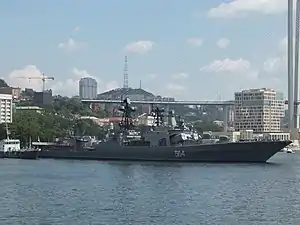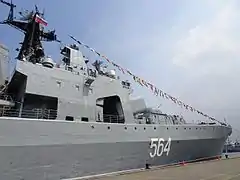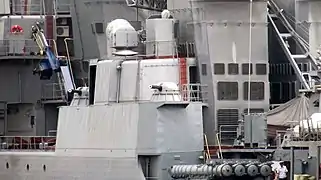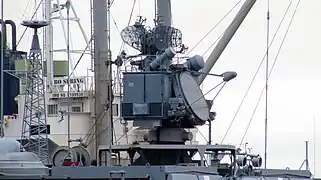Russian destroyer Admiral Tributs
Admiral Tributs (Адмирал Трибуц) is a Project 1155 Large Anti-Submarine Ship (Большой Противолодочный Корабль, BPK) of the Russian Navy. Known in the west as an Udaloy-class destroyer, the ship is named after Vladimir Filippovich Tributs. Launched in 1983, Admiral Tributs serves in the Russian Pacific Fleet, and has taken part in operations alongside the naval forces of other nations like China, India and Japan, and as part of a peacekeeping force in the Middle East between 1992 and 1993.
 Admiral Tributs in Vladivostok | |
| History | |
|---|---|
| Name: | Admiral Tributs |
| Namesake: | Vladimir Filippovich Tributs |
| Builder: | A.A. Zhdanov, Leningrad |
| Yard number: | 783 |
| Laid down: | 19 April 1980 |
| Launched: | 26 March 1983 |
| Commissioned: | 30 December 1985 |
| Identification: | BPK |
| Status: | in active service |
| General characteristics | |
| Class and type: | Udaloy-class destroyer |
| Displacement: |
|
| Length: | 163 m (535 ft) |
| Beam: | 19.3 m (63 ft) |
| Draught: | 7.8 m (26 ft) |
| Propulsion: | 2 shaft COGAG, 4 gas turbines, 89,000 kW (120,000 hp) |
| Speed: | 35 knots (65 km/h; 40 mph) |
| Range: | 10,500 nautical miles (19,400 km) at 14 knots (26 km/h; 16 mph) |
| Complement: | 300 |
| Sensors and processing systems: |
|
| Electronic warfare & decoys: |
|
| Armament: |
|
| Aircraft carried: | 2 x Ka-27 'Helix' series helicopters |
| Aviation facilities: | Helicopter deck and hangar |
Design
Admiral Tributs is the sixth ship of a class of twelve Project 1155 Fregat (also known as the Udaloy-class). The vessel is designated as a Large Anti-Submarine Ship (Большой Противолодочный Корабль, BPK) in accordance with its primary mission of countering submarines and a destroyer by NATO.[1]
The vessel is 163 m (534.8 ft) long with a beam of 19.3 m (63.3 ft) and a draught of 7.8 m (25.6 ft). Displacement was 6,200 t (6,102 long tons) standard and 7,900 t (7,775 long tons) full load.[2] Power is provided by four 23,000 kW (31,000 hp) hp GTA M-9 propulsion complexes, each comprising a 6,300 kW (8,500 hp) M-62 and a 16,800 kW (22,500 hp) hp M-8KF powering two fixed pitch propellers. which gave a maximum speed of 29.5 knots (55 km/h; 34 mph).[3] Cruising range was 6,882 nmi (12,745 km; 7,920 mi) at 14 kn (26 km/h; 16 mph) and 4,000 nmi (7,408 km; 4,603 mi) at 18 kn (33 km/h; 21 mph).[3]
Armament
To combat submarines, Admiral Tributs mounts two quadruple launchers for eight missiles in the Metel Anti-Ship Complex along with two RBU-6000 12-barrel rocket launchers for close in defence.[4] The ship is also equipped with two quadruple 553 mm (21.8 in) CHTA-53-1155 torpedo tubes for 53-65K, SET-65 torpedoes.[3] A hangar aft accommodates two Kamov Ka-27 helicopters for anti-submarine warfare.[1] Protection from aircraft was provided with eight 3K95 Kinzhal missiles mounted in vertical launchers supplemented by 100 mm (4 in) AK-100 DP guns and four 30 mm (1.2 in) AK-630 Gatling guns.[5]
Electronic warfare
The vessel is equipped with the MR-760 Fregat-MA (NATO reporting name 'Top Plate') air/surface search, MR-320V Topaz-V ('Strut Pair') air/surface search and MR-212/201-1 Vaygach-U navigation radars along with MR-350 Podkat ('Cross Sword') and K-12-1 ('Hot Flash') fire control radars.[6] The MGK-355 Polinom sonar complex (combining 'Horse Jaw' bow mounted and 'Horse Tail' variable depth sonars) is complemented by two MG-7 Braslet anti-saboteur sonars and the MG-35 Shtil-2 underwater communication system.[7]
Service
Admiral Tributs was laid down on 19 April 1980 and launched on 26 March 1983.[4] The ship is named after Vladimir Filippovich Tributs.[2]
On commissioning in December 1916, was accepted into the Pacific Fleet on 15 February 1986 and attached to the 183rd Anti-Submarine Warfare Brigade. The ship served in the Indian Ocean in 1987, visiting Aden, South Yemen, and 1990, visiting Penang, Malaysia. Between 5 December 1992 and 23 May 1993, the vessel undertook peacekeeping duties in the Persian Gulf, followed by a lengthy modernisation at Dalzavod, Vladivostok that lasted from March 1994 to March 2003.[8]
Resuming service, between 10 and 15 February 2004, Admiral Tributs joined Varyag on a visit to Incheon, South Korea, to celebrate the centenary of the battle between Varyag and the Japanese fleet during the Battle of Chemulpo Bay. In 2005, the vessel took part in joint exercises with India, visited Tanjung Priok, Indonesia, Singapore. Sattahip, Thailand, Danang, Vietnam, Victoria, Seychelles and Klang, Malaysia, took part in exercises with Moskva and Pyotr Velikiy and joint exercises with the Japan Maritime Self-Defense Force alongside Admiral Panteleyev. Following a visit to Ho Chi Minh City, Vietnam, in April 2012, the vessel joined sisterships Admiral Vinogradov and Marshal Shaposhnikov for joint exercises with the People's Liberation Army Navy.[8]
Pennant numbers
| Pennant Number[3] | Date |
|---|---|
| 415 | 1985 |
| 472 | 1987 |
| 592 | 1988 |
| 552 | 1992 |
| 564 | 1993 |
Gallery
 Admiral Tributs moored at Tanjung Priok in Jakarta
Admiral Tributs moored at Tanjung Priok in Jakarta Admiral Tributs moored at Manilla South Harbour
Admiral Tributs moored at Manilla South Harbour KT-106U launchers for 84R/URPK-4 Metel-U anti-submarine missiles on Admiral Tributs
KT-106U launchers for 84R/URPK-4 Metel-U anti-submarine missiles on Admiral Tributs Rear view of the two 100 mm AK-100 guns of Admiral Tributs
Rear view of the two 100 mm AK-100 guns of Admiral Tributs An RBU-6000 Anti Submarine Rocket Launcher on Admiral Tributs
An RBU-6000 Anti Submarine Rocket Launcher on Admiral Tributs The Masts and Radars of Admiral Tributs
The Masts and Radars of Admiral Tributs Side view of an AK-630 Close In Weapons System (CIWS) of Admiral Tributs
Side view of an AK-630 Close In Weapons System (CIWS) of Admiral Tributs An MR360 Cross Sword Fire Control Radar (FCR) of the Admiral Tributs
An MR360 Cross Sword Fire Control Radar (FCR) of the Admiral Tributs Rear view of an Ka-27 Anti-Submarine Warfare (ASW) Helicopter of Admiral Tributs
Rear view of an Ka-27 Anti-Submarine Warfare (ASW) Helicopter of Admiral Tributs
References
Citations
- Jordan 1983, p. 111.
- Jordan 1983, p. 122.
- Volkov & Brichevsky 2016.
- Wertheim 2005, p. 623.
- Prezelin & Baker 1995, p. 536.
- Wertheim 2005, p. 625.
- Prezelin & Baker 1995, p. 493.
- Holm 2015.
Bibliography
- Jordan, John (1983). Soviet Warships: The Soviet Surface Fleet, 1960 to the Present. London: Arms and Armour Press. ISBN 978-0-85368-584-5.CS1 maint: ref=harv (link)
- Holm, Michael (2015). "Project 1155 Udaloy class". Soviet Armed Forces 1945–1991. Retrieved 18 November 2017.CS1 maint: ref=harv (link)
- Prezelin, Bernard; Baker, A. D. (1995). Combat Fleets of the World. Annapolis, MD: Naval Institute Press. ISBN 978-1-55750-109-7.CS1 maint: ref=harv (link)
- Volkov, Roman; Brichevsky, Andrew (2016). "Large Anti-Submarine Ships – Project 1155". Russian Ships. Retrieved 18 November 2017.CS1 maint: ref=harv (link)
- Wertheim, Eric (2005). The Naval Institute Guide to Combat Fleets of the World. Annapolis, Maryland: US Naval Institute Press. ISBN 9781591149347.CS1 maint: ref=harv (link)
External links
- Gogin, Ivan (2015). "UDALOY large ASW ships (project 1155) (1980 - 1991)". Retrieved 18 November 2017.
